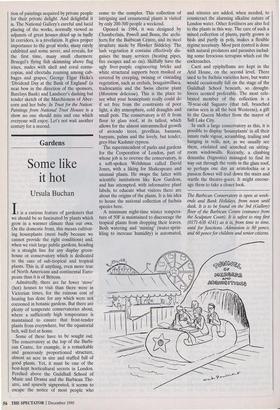Gardens
Some like it hot
Ursula Buchan
It is a curious feature of gardeners that we should be so fascinated by plants which grow in a warmer climate than our own. On the domestic front, this means cultivat- ing houseplants (most badly because we cannot provide the right conditions) and, when we visit large public gardens, heading in a straight line for any display green- house or conservatory which is dedicated to the care of sub-tropical and tropical plants. This is, if anything, even more true of North Americans and continental Euro- peans than it is of Britons.
Admittedly, there are far fewer 'stove' (hot) houses to visit than there were in Victorian times, for the ruinous cost of heating has done for any which were not cocooned in botanic gardens. But there are plenty of temperate conservatories about, where a sufficiently high temperature is maintained to ensure that frost-tender plants from everywhere, bar the equatorial belt, will feel at home.
Some of these have to be sought out. The conservatory at the top of the Barbi- can Centre, for example, is a remarkable and generously proportioned structure, almost an acre in size and stuffed full of good plants. Yet, it must be one of the best-kept horticultural secrets in London. Perched above the Guildhall School of Music and Drama and the Barbican The- atre, and sparsely signposted, it seems to escape, the notice of most people who come to the complex. This collection of intriguing and ornamental plants is visited by only 200-300 people a weekend.
Opened in 1984, it was designed by Chamberlain, Powell and Bonn, the archi- tects for the Barbican Centre, and its steel structure made by Hawker Siddeley. The lush vegetation it contains effectively dis- guises the many services (heating pipes, fire escapes and so on). Skilfully have the ugly liver-purple engineering bricks and white structural supports been masked or covered by creeping, twining or cascading vegetation, such as orchids, bougainvillaea, tradescantia and the Swiss cheese plant (Monstera deliciosa). This is the place to see what your houseplants really could do if set free from the constraints of poor light, a dry atmosphere, cold draughts and small pots. The conservatory is 65 ft from floor to glass roof, at its tallest, which allows for the almost untrammelled growth of avocado trees, grevilleas, bananas, banyans, palms and the lovely, but tender, grey-blue Kashmir cypress.
The superintendent of parks and gardens for the Corporation of London, part of whose job is to oversee the conservatory, is a soft-spoken Welshman called David Jones, with a liking for Shakespeare and unusual plants. He swaps the latter with scientific institutions like Kew Gardens, and has attempted, with informative plant labels, to educate what visitors there are about the origins of the plants. It is his idea to house the national collection of fuchsia species here.
A minimum night-time winter tempera- ture of 50F is maintained to discourage the tropical plants from dropping their leaves. Both watering and 'misting' (water-sprin- kling to increase humidity) is automated, and nitrates are added, when needed, to counteract the alarming alkaline nature of London water. Other fertilisers are also fed to the plants in this way. The care of such a mixed collection of plants, partly grown in beds and partly in pots, makes a flexible regime necessary. Most pest control is done with natural predators and parasites includ- ing some ferocious terrapins which eat the cockroaches.
Cacti and epiphyllums are kept in the Arid House, on the second level. There used to be fuchsia varieties here, but water would occasionally fall on the stage of the Guildhall School beneath, so drought- lovers seemed preferable. The most cele- brated member of the collection is a 70-year-old Saguaro (that tall, branched cactus seen in all the best Westerns), a gift to the Queen Mother from the mayor of Salt Lake City.
In such a large conservatory as this, it is possible to display 'houseplants' in all their innate rude vigour, scrambling, trailing and hanging in veils, not, as we usually see them, etiolated and scorched on sitting- room windowsills. Recently, a climbing doxantha (bignonia) managed to find its way out through the vents in the glass roof, so perhaps one day an aristolochia or a passion flower will trail down the stairs and startle the theatre-goers. It might encour- age them to take a closer look.
The Barbican Conservatory is open at week- ends and Bank Holidays, from noon until dusk. It is to be found on the 3rd (Gallery) floor of the Barbican Centre (entrance from the Sculpture Court). It is safest to ring first (0171-638 4141) as it is, from time to time, used for functions. Admission is 80 pence, and 60 pence for children and senior citizens.










































































 Previous page
Previous page